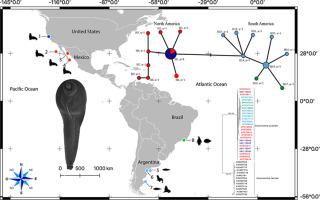Parasitology International ( IF 1.5 ) Pub Date : 2020-10-09 , DOI: 10.1016/j.parint.2020.102205 Martín García-Varela 1 , Alice Masper 2 , Enrique A Crespo 3 , Jesús S Hernández-Orts 4

|
Adult specimens of Corynosoma australe Johnston, 1937 were recorded from the intestines of California sea lions, Zalophus californianus (Lesson), from Baja California Peninsula, Mexico, whereas larval forms were collected from two fish species on the Argentinian coast. Adult specimens of C. australe were morphologically characterized by having a cylindrical proboscis with 18–20 rows of 12–14 hooks per row and a cylindrical trunk expanded anteriorly into a disk with tiny, triangular spines spreading almost to three quarters of the hind-trunk in males and to the posterior body end in females. The aim of this study was to explore the genetic diversity and systematic position of C. australe distributed in the Americas. Newly generated sequences of the mitochondrial cytochrome c oxidase subunit 1 (cox 1) gene were compared with sequences available from GenBank.
Phylogenetic analyses performed with the cox 1 dataset using maximum likelihood and Bayesian inference showed that the 11 new sequences of C. australe recovered from the California sea lion in northern Mexico plus the six sequences from Argentinian seashores formed a clade with other sequences of specimens previously identified as C. australe. The intraspecific genetic divergence among the isolates was very low, ranging from 1 to 1.7%, and in combination with the phylogenetic trees confirmed that the isolates belonged to the same species. The cox 1 haplotype network inferred with 27 sequences revealed 18 haplotypes divided into two clusters clearly separated from each other by 5 substitutions. The first cluster corresponded to specimens from the Northern Hemisphere (United States of America and Mexico), and the second corresponded to specimens from the Southern Hemisphere (Argentina and Brazil). The current evidence suggests that C. australe has an amphitemperate distribution and is associated mainly with otariids with secondary and independent colonization events to other mammals and the Magellanic penguin in the Southern Hemisphere.
中文翻译:

1937年澳大利亚约翰氏Corynosoma australe的遗传多样性和系统地理学(棘头足目:多形科),是北美和南半球来自美洲的OTARIID的内寄生物。
1937年,从墨西哥下加利福尼亚半岛的加利福尼亚海狮小肠Zalophus californianus(Lesson)的肠道中记录到了澳大利亚约翰逊Corynosoma的成年标本,而从阿根廷海岸的两种鱼类中采集了幼体。成年C. australe的形态特征是圆柱形长鼻,每行18–20行,每行12–14个钩,圆柱形树干向前方扩展成盘状,细小的三角形棘几乎扩展到后躯的四分之三在男性和女性的后身体末端。本研究的目的是探索分布在美洲的C. australe的遗传多样性和系统地位。将新产生的线粒体细胞色素C氧化酶亚基1(cox 1)基因的序列与GenBank提供的序列进行了比较。
用最大似然和贝叶斯推论对cox 1数据集进行的系统发育分析表明,从墨西哥北部加利福尼亚海狮中发现的11条新的澳洲梭菌序列与阿根廷海岸的6条序列形成了与之前鉴定的其他标本序列的进化枝作为C. australe。分离株之间的种内遗传差异非常低,范围在1%至1.7%之间,并且与系统进化树相结合,证实分离株属于同一物种。在COX 1用27个序列推断的单倍型网络揭示了18个单倍型,分为两个簇,彼此之间明显地隔开5个取代。第一组对应于北半球(美利坚合众国和墨西哥)的标本,第二组对应于南半球(阿根廷和巴西)的标本。目前的证据表明,C. AUSTRALE具有amphitemperate分布并且主要与具有仲和独立定植事件其他哺乳动物和南半球的麦哲伦企鹅otariids。











































 京公网安备 11010802027423号
京公网安备 11010802027423号